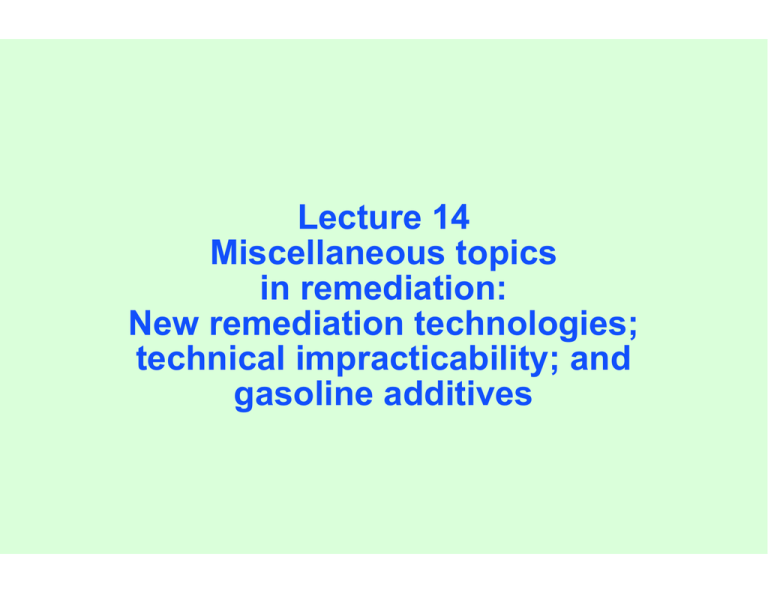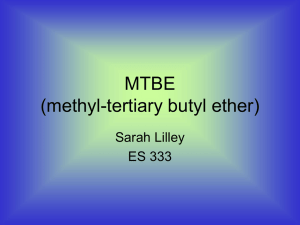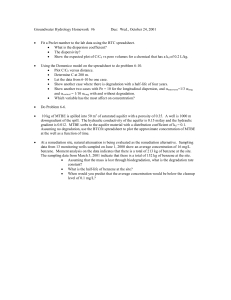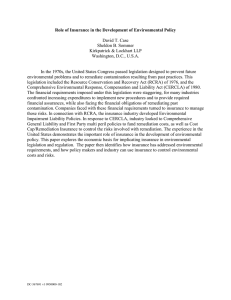Lecture 14 Miscellaneous topics in remediation: New remediation technologies;
advertisement

Lecture 14 Miscellaneous topics in remediation: New remediation technologies; technical impracticability; and gasoline additives New remediation technologies Phytoremediation Electro-kinetic remediation Bedrock fracturing Circulating wells/in-well treatment In-situ oxidation Dual-phase vapor extraction Phytoremediation Plant Metabolism Plant Uptake Biodegradation in the Rhizosphere Root Absorbtion Contaminants Phytoremediation Phytotransformation – uptake from soil and ground water, transformation within the plant Rhizosphere bioremediation – augmentation of bacterial processes in plant root zone Phytostabilization – hydraulic control by pumping action of trees, physical soil stabilization by roots Phytoextraction – use of metal-accumulating plants to extract metals from soils and concentrate them in roots, stems, or leaves Rhizofiltration – plant roots acting to sorb, concentrate, or precipitate metals Explosives rhizosphere bioremediation Artificial wetland constructed in gravel base reduced total explosives (TNT, RDX, HMX) from 9200 to 50 ppb. Source: Defense Environmental Restoration Program, undated. “The Role of Technology.” http://www.dtic.mil/envirodod/derpreport96/vol1/technol.html Acccessed March 28, 2004. Poplar trees for phytoextraction Courtesy of Melanie Pincus. Used with permission. Source: Pincus, M., 2003. Greener Cleaners, Using Phytoremediation to Remediate Environmental Toxins. Student paper for MIT Course 1.34. Wild mustard plant for metals phytoextraction Wild mustard plant will hyperaccumulate nickel, reaching shoot concentrations as high as 1.2%. Persans, M. W., K. Nieman, and D. E. Salt, 2001. Functional activity and role of cation-efflux family members in Ni hyperaccumulation in Thlaspi goesingense. PNAS. Vol. 98, No. 17, Pg. 9995-10000. August 14, 2001. Courtesy of David Salt. Used with permission. Source: Salt, David E., undated. Molecular Physiology of Heavy Metal Accumulation and Tolerance in Plants. Horticulture and Landscape Architecture, Purdue University, West Lafayette, Indiana. http://www.hort.purdue.edu/hort/people/faculty/salt.shtml. Accessed March 28, 2004. Persans, M. W., K. Nieman, and D. E. Salt, 2001. Functional activity and role of cation-efflux family members in Ni hyperaccumulation in Thlaspi goesingense. PNAS. Vol. 98, No. 17, Pg. 999510000. August 14, 2001. The ability of Thlaspi goesingense to hyperaccumulate Ni seems to be governed in part by enhanced accumulation of Ni within leaf vacuoles. We have characterized genes from T. goesingense encoding putative vacuolar metal ion transport proteins, termed metal tolerance proteins (TgMTPs). These proteins contain all of the features of cation-efflux family members, and evidence indicates they are derived from a single genomic sequence (TgMTP1) that gives rise to an unspliced (TgMTP1t1) and a spliced (TgMTP1t2) transcript. Heterologous expression of these transcripts in yeast lacking the TgMTP1 orthologues COT1 and ZRC1 complements the metal sensitivity of these yeast strains, suggesting that TgMTP1s are able to transport metal ions into the yeast vacuole in a manner similar to COT1 and ZRC1. The unspliced and spliced TgMTP1 variants differ within a histidine-rich putative metal-binding domain, and these sequence differences are reflected as alterations in the metal specificities of these metal ion transporters. When expressed in yeast, TgMTP1t1 confers the highest level of tolerance to Cd, Co, and Zn, whereas TgMTP1t2 confers the highest tolerance to Ni. TgMTP1 transcripts are highly expressed in T. goesingense compared with orthologues in the nonaccumulators Arabidopsis thaliana, Thlaspi arvense, and Brassica juncea. We propose that the high-level expression of TgMTP1 in T. goesingense accounts for the enhanced ability of this hyperaccumulator to accumulate metal ions within shoot vacuoles. Electrokinetic remediation Source: Van Deuren, J., T. Lloyd, S. Chhetry, R. Liou, and J. Peck, 2002. Remediation Technologies Screening Matrix and Reference Guide, 4th Edition. Federal Remediation Technologies Roundtable. Lasagna process Electro-osmosis moves contaminant in low permeability environments http://www.em.doe.gov/emprog/spr009.html The Lasagna™ process works by using buried electrodes to move water through the soil. Applied current drives the water an inch a day from a positive to a negative electrode. The water picks up contaminants and moves them through treatment zones where they are trapped or degraded. Thermal treatment (enhanced SVE) See image in Bader, C. D., 1997. In-Situ Soil Remediation. Remediation Management. Vol. 3, No. 2, Pg. 22. Second Quarter 1997. Thermal treatment of PCBs in soil See image in Bader, C. D., 1997. In-Situ Soil Remediation. Remediation Management. Vol. 3, No. 2, Pg. 22. Second Quarter 1997. After thermal treatment See image in Bader, C. D., 1997. In-Situ Soil Remediation. Remediation Management. Vol. 3, No. 2, Pg. 22. Second Quarter 1997. Fracturing of low-conductivity geologic media Pneumatic Pressure Source 2-ft Fracture Interval Circulating wells Source: Van Deuren, J., T. Lloyd, S. Chhetry, R. Liou, and J. Peck, 2002. Remediation Technologies Screening Matrix and Reference Guide, 4th Edition. Federal Remediation Technologies Roundtable. In-well air stripping Vapors are extracted for exsitu vapor treatment Source: Van Deuren, J., T. Lloyd, S. Chhetry, R. Liou, and J. Peck, 2002. Remediation Technologies Screening Matrix and Reference Guide, 4th Edition. Federal Remediation Technologies Roundtable. Density-driven convection Vapors are discharged to vadose zone for in-situ degradation Source: Van Deuren, J., T. Lloyd, S. Chhetry, R. Liou, and J. Peck, 2002. Remediation Technologies Screening Matrix and Reference Guide, 4th Edition. Federal Remediation Technologies Roundtable. Dual-phase vapor extraction Source: U.S. EPA, 1999. Multi-Phase Extraction: State-of-the-Practice. Report No. EPA 542-R-99-004. Office of Solid Waste and Emergency Response, U.S. Environmental Protection Agency, Washington, D.C. June 1999. Dual-phase extraction (DPE) well Source: U.S. EPA, 1999. Multi-Phase Extraction: State-ofthe-Practice. Report No. EPA 542-R-99-004. Office of Solid Waste and Emergency Response, U.S. Environmental Protection Agency, Washington, D.C. June 1999. Dual-phase extraction Source: U.S. EPA, 1997. Presumptive Remedy: Supplemental Bulletin Multi-Phase Extraction (MPE) Technology for VOCs in Soil and Groundwater. Report No. EPA-540-F-97-004. Office of Solid Waste and Emergency Response, U.S. Environmental Protection Agency, Washington, D.C. April 1997. Two-phase extraction Source: U.S. EPA, 1997. Presumptive Remedy: Supplemental Bulletin Multi-Phase Extraction (MPE) Technology for VOCs in Soil and Groundwater. Report No. EPA-540-F-97-004. Office of Solid Waste and Emergency Response, U.S. Environmental Protection Agency, Washington, D.C. April 1997. Chemical oxidation Uses strong oxidizer to chemically destroy contaminants Mixed with soil Injected into ground water Oxidating agents: Peroxide Ozone Permanganate Chemical oxidation Source: Van Deuren, J., T. Lloyd, S. Chhetry, R. Liou, and J. Peck, 2002. Remediation Technologies Screening Matrix and Reference Guide, 4th Edition. Federal Remediation Technologies Roundtable. The rate and extent of degradation of a target COC are dictated by the properties of the chemical itself and its susceptibility to oxidative degradation as well as the matrix conditions, most notably, pH, temperature, the concentration of oxidant, and the concentration of other oxidant-consuming substances such as natural organic matter and reduced minerals as well as carbonate and other free radical scavengers. Given the relatively indiscriminate and rapid rate of reaction of the oxidants with reduced substances, the method of delivery and distribution throughout a subsurface region is of paramount importance. Oxidant delivery systems often employ vertical or horizontal injection wells and sparge points with forced advection to rapidly move the oxidant into the subsurface. Permanganate is relatively more stable and relatively more persistent in the subsurface; as a result, it can migrate by diffusive processes. Consideration also must be given to the effects of oxidation on the system. All three oxidation reactions can decrease the pH if the system is not buffered effectively. Other potential oxidation-induced effects include: colloid genesis leading to reduced permeability; mobilization of redox-sensitive and exchangeable sorbed metals; possible formation of toxic byproducts; evolution of heat and gas; and biological perturbation Oxidizing agents: Peroxide Peroxide – usually in form of Fenton’s reagent: H2O2 + Fe2+ H2O2 + Fe2+ → OH (radical) + OH– + Fe3+ OH radical is extremely strong oxidizer Net reaction: 3H2O2 + C2HCl3 → 2CO2 + 2H2O + 3HCl Requires acidic conditions (pH 2 to 4) Oxidizing agents: Peroxide Applicability: most organic compounds Not effective against TCA Application issues: Dangerous chemical Generates large quantities of heat Generates gases (CO2+ O2) Other substances may be oxidized, limiting effectiveness Transport to oxidation site may be limiting Field trial of Fenton’s Reagent See image in Bryant, J. D. and J. T. Wilson, 1998. "Field Demonstration of In-Situ Fenton's Reagent Destruction of DNAPLS." Environmental Technology, Vol. 8, No. 3, Pp. 55-59. May/June 1998. Oxidizing agents: Permanganate Usually potassium permanganate: KMnO4 but also Ca, Na, and Mg permanganate Exact mechanism of oxidation unknown Net reaction: 2KMnO4 + C2HCl3 → 2CO2 + 2MnO2 + HCl Oxidizer comparison Treatment Efficiency (%Red) 100 80 H2O2 60 H2O2 + Fe(II) 40 KMnO4 20 0 Clay TCE Sand TCE Clay PCE Sand PCE Soil and VOC Comparison of Soil Treatment with H2O2 (25.5 g/kg), H2O2 Plus Iron (25.5 g/kg +5 mM FeSO4), or KMnO4 (15.0 g/kg) Adapted from: Gates-Anderson, D. D., R. L. Siegrist, and S. R. Cline. "Comparison of Potassium Permanganate and Hydrogen Peroxide as Chemical Oxidants for Organically Contaminated Soils." Journal of Environmental Engineering, ASCE 127, no. 4 (2001): 337-347. Treatment Efficiency (%Red) Oxidizer comparison 100 80 H2O2 60 H2O2 + Fe(II) 40 KMnO4 20 0 Clay Clay Clay Naphthalene Phenanthrene Pyrene Sand Sand Sand Naphthalene Phenanthrene Pyrene Soil and SVOC SVOC Treatment Efficiency in Clay Soil Treated for 48 h with H2O2 (39 g/kg), H2O2 Plus Iron (39 g/kg + 5 mM FeSO4), or KMnO4 (16 g/kg) (Initial Concentrations: Naphthalene = 260-337 mg/kg, Phenanthrene = 248-341 mg/kg, and Pyrene = 226-331 mg/kg) Adapted from: Gates-Anderson, D. D., R. L. Siegrist, and S. R. Cline. "Comparison of Potassium Permanganate and Hydrogen Peroxide as Chemical Oxidants for Organically Contaminated Soils." Journal of Environmental Engineering, ASCE 127, no. 4 (2001): 337-347. Oxidizing agents: Ozone Ozone – O3 Ozone gas can be injected by sparging SITE: Superfund Innovative Technology Evaluation Program Federal Remediation Technologies Roundtable Images\FRTR TOC.htm TechDirect Newsletter Cost estimating resources • CLU-IN Web Site http://www.clu-in.org/ • EPA reports • Historical cost analysis system (HCAS) http://globe.lmi.org/lmi_hcas/ • Environmental Cost-Handling Options and Solutions (ECHOS) – R.S. Means Company Technical impracticability EPA Directive “EPA’s goal of restoring contaminated ground water within a reasonable timeframe at Superfund or RCRA sites will be modified where complete restoration is found to be technically impracticable. In such cases, EPA will select an alternative remedial strategy that is technically practicable, protective of human health and the environment, and satisfies the statutory and regulatory requirements of the Superfund or RCRA programs as appropriate.” TI Requirements Identify ARARs to be waived Specify spatial extent for TI waiver Develop site conceptual mode Provide thorough characterization of site Evaluate restoration potential Provide cost estimates Evaluation of restoration potential Source control measures TI waiver for ground water requires demonstration of source control Remedial action performance analysis High quality, detailed ground-water monitoring Effective operation of existing ground-water remedy Evaluate remedy modifications Evaluate trends over time REILLY TAR & CHEMICAL SITE Gasoline Additives Introduced in late 1970s during phase-out of lead additives Two uses: Oxygenated fuel (oxyfuel) – promotes more complete combustion of hydrocarbons Reformulated gasoline – reduced benzene and aromatics to reduce ozone formation for air quality Gasoline Oxygenates Oxygenates: MTBE – methyl tert butyl ether ethanol ethyl tert butyl ether methanol tertiary butyl alcohol – TBA Oxinol™ – blend of methanol and TBA Increase octane rating of gasoline Reduce emissions of air pollutants Growth in use of MTBE 1970 – 39th highest production organic chemical 1998 – 4th highest production Production (Millions of Kilograms) 1960s – first formulated by ARCO 1,2-Dichloroethane (3) 104 Ethylene (1) 103 Vinyl Chloride (5) Propylene (2) Benzene (6) MTBE (4) (Organic Chemical Production Rank in 1998) Perchloroethylene (40) 102 Trichloroethylene (Not Ranked) 1970 1975 1980 1985 1990 1995 Year Adapted from: Johnson, R., J. Pankow, D. Bender, C. Price, and J. Zogorski. "MTBE, To What Extent Will Past Releases Contaminate Community Water Supply Wells?" Environmental Science & Technology 34, no. 9 (May 1, 2000): 210 A-217 A. Use of MTBE Used in 13 states as oxyfuel 3% of all oxyfuel 10-15% by volume of oxyfuel gasoline Used in 18 states as reformulated gas 85% of all RFG 11-15% by volume of RFG gasoline Present in most parts of country as part of gasoline product stream 88% of Kansas UST sites Methyl tertiary Butyl Ether - MTBE CH3 CH3 O C CH3 CH3 MTBE Properties Extremely soluble: 4700 mg/L from RFG 6300 mg/L from oxyfuel Versus BTEX from conventional gasoline: 18 mg/L benzene 25 mg/L toluene 3 mg/L ethylbenzene 20 mg/L total xylenes MTBE Properties Very low solid partition coefficient (Rd ≅ 1) Does not biodegrade readily Possible human carcinogen Drinking water advisory – 20 to 40 µg/L Not highly volatile Readily partitions from atmosphere to precipitation Difficult to treat Prevalence of MTBE Found at background concentrations of 0.2 to 3 µg/L due to prevalence in precipitation In USGS national surveys: Found above detection limit in 83% of stormwater samples Found in 27% of ground-water samples Found at large majority of LUST sites Significant problems in California including high concentration in Santa Monica public supply wells Example MTBE Site Leak in tank valve at fuel storage facility, Woodbury, New Jersey Hydrogeology: silty sands of moderate hydraulic conductivity Feb. 1992 Initial release Dec. 1992 MTBE = 18 ug/L BTEX < 1 ug/L Feb. 1993 MTBE = 490 ug/L BTEX = 27 ug/L MTBE = 63 ug/L BTEX < 4 ug/L June 1993 MTBE = 190 ug/L BTEX = 2700 ug/L MTBE = 1.9 ug/L BTEX < 4 ug/L Nov. 1993 MTBE = 15 ug/L BTEX < 4 ug/L




